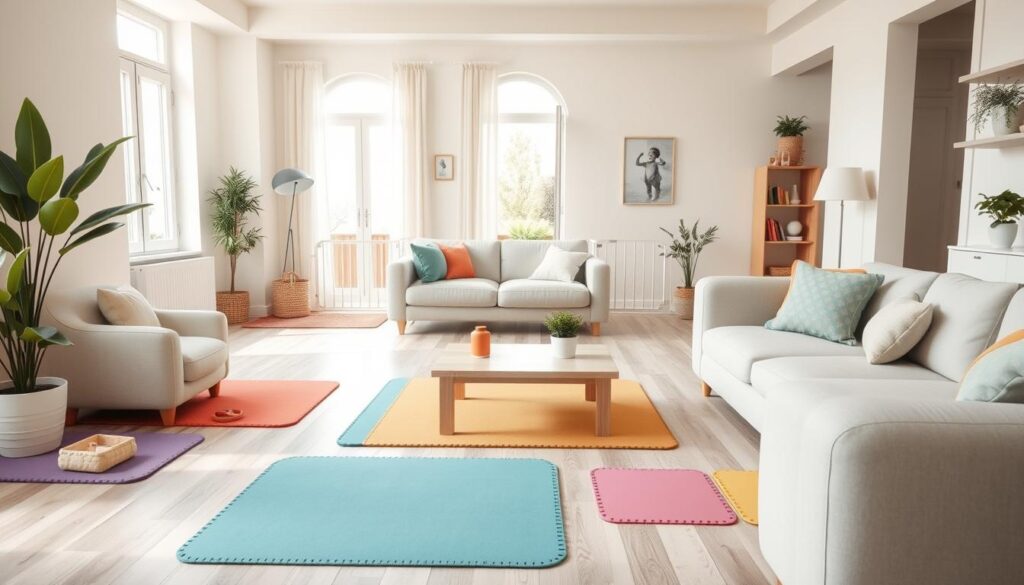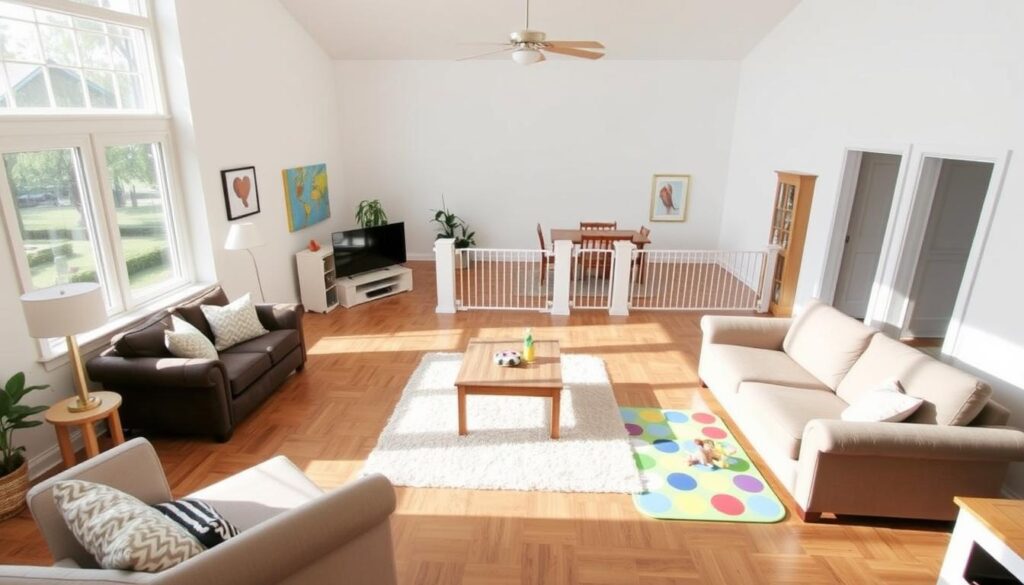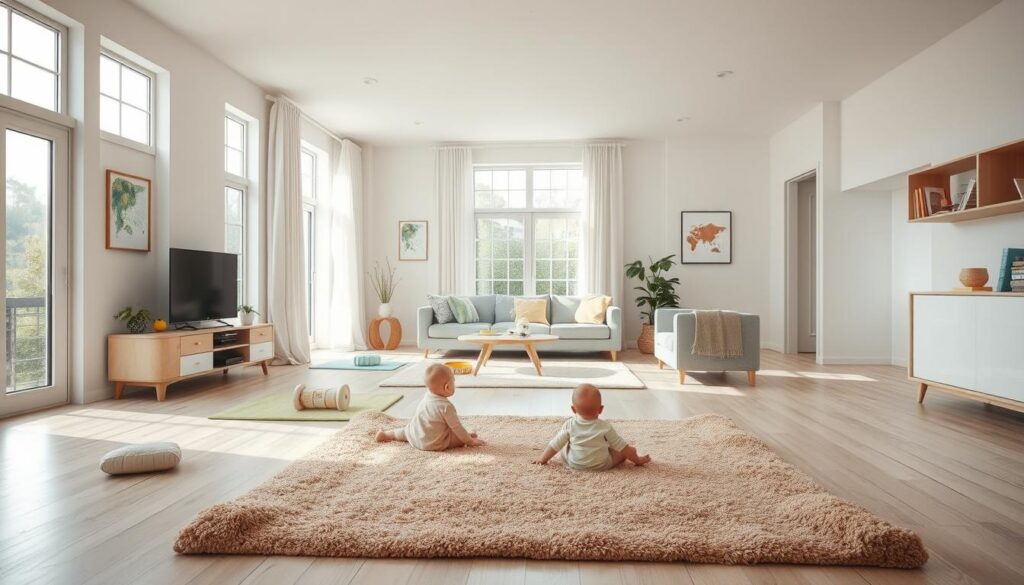As a parent, I aim to make a safe and welcoming space for my child. I’m searching for a detailed guide on baby proofing open floor plans. With open floor plans becoming more common, it’s crucial to take extra steps for child safety. Can I find a way to mix style with safety in my open floor plan home?

The American Academy of Pediatrics says baby proofing is key to preventing accidents at home. This is especially true for open floor plans, where child safety is a major concern. In this article, we’ll give a full safety guide on baby proofing open floor plans. We’ll cover why it’s important, common safety risks, and share practical tips for a safe and secure space for my child.
Table of Contents
Key Takeaways
- Understanding the importance of baby proofing in open floor plans
- Identifying common safety risks in open spaces
- Learning practical tips for creating a safe and secure environment
- Discovering ways to balance style and child safety
- Implementing effective baby proofing solutions for open floor plans
- Creating a welcoming and safe space for my child
Understanding the Challenges of Baby Proofing Open Floor Plans
As a parent, I want to know how to baby proof open floor plans. These spaces can be tricky because they’re open and easy to get into. It’s important to find and fix safety risks to keep my child safe.
Open floor plans have both good and bad sides. They’re great for seeing everything, which helps me watch my child. But, they also mean my child can get into danger zones like the kitchen or living room.
Common Safety Risks in Open Spaces
Open spaces can have dangers like sharp corners, heavy furniture, and electrical outlets. To fix these, I can secure furniture, cover outlets, and pad sharp corners.
Benefits of Open Floor Plans for Monitoring
Open floor plans are good for keeping an eye on my child. I can see everything easily, so I can act fast if something goes wrong.
Assessment of Your Space
To check my home for safety risks, I’ll do a full walk-through. I’ll look for dangers like sharp corners or heavy furniture. By being proactive, I can make my child’s space safe and secure in an open floor plan.
Essential Safety Equipment for Open Space Protection
As a parent, I always look for the best safety equipment for my child in an open floor plan. Safety equipment is key to keeping my child safe. Items like baby gates, locks, and alarms are must-haves to avoid accidents.
I pick the right safety gear by thinking about my home’s layout and hazards. For example, baby gates stop falls at stairs. Locks keep cabinets and drawers safe from harmful stuff.
Some important safety gear includes:
- Baby gates for stairs and rooms
- Locks for cabinets and drawers
- Alarms for doors and windows
Getting the right safety equipment makes my home safe for my child. It’s important to find what works best for my needs and keeps my child safe.
Remember, safety gear is an ongoing need. It needs regular checks to stay effective. By focusing on safety, I can enjoy an open floor plan without worrying about risks.
Creating Safe Zones in Your Open Floor Plan
As a parent, I aim to make a safe and welcoming space for my child. I do this by setting up safe zones in my open floor plan. This means creating specific areas for play and rest to lower the risk of accidents.
Setting up barriers helps separate different parts of the house. For example, I can use them to keep the kitchen and living room apart.
It’s also key to have play areas for my child. I can use a playpen or a special area with soft floors and few dangers. I also use barriers to keep my child away from risky spots like the kitchen or bathroom.
Designating Play Areas
- Set up a playpen or designated play area with soft flooring
- Use barriers to block off areas that are not safe for my child
- Place toys and other play materials in easy-to-reach locations
Setting Up Barriers
Using barriers is a smart way to make safe zones in my open floor plan. I can use baby gates or other barriers to keep my child away from danger. This helps prevent accidents and lets me relax when my child is playing.
| Type of Barrier | Purpose |
|---|---|
| Baby Gate | To block off stairs or other hazardous areas |
| Playpen | To create a designated play area |
Furniture Arrangement Strategies for Maximum Safety
As a parent, I aim to set up my furniture for safety and security. The right furniture arrangement can prevent accidents and injuries at home. By planning our living space, we can make a safer and calmer place for our kids.
It’s key to think about natural boundaries in our home. We can do this by arranging furniture to create different zones. For example, a play area for kids and a quiet spot for adults. This reduces distractions and lowers the chance of accidents.
Creating a Safe and Functional Space
Securing heavy furniture to walls is vital to prevent it from falling. This is crucial in areas where kids play or run. By doing this, we ensure a safe and useful space for our family.

Optimizing Layout for Maximum Safety
Here are some tips for better furniture arrangement:
- Keep heavy furniture away from doors and windows.
- Make sure there’s a clear path for walking and playing.
- Use furniture arrangement to set up natural boundaries and areas.
By using these tips, we can make a safe and inviting space for our children to grow and flourish.
Kitchen Safety Solutions in Open Concept Homes
As a parent, I aim to make my kitchen safe for my child in our open concept home. I want them to explore and play without fear of danger. To do this, I install safety latches on cabinets and drawers. I also secure appliances and keep harmful substances out of reach.
Some key considerations for kitchen safety in open concept homes include:
- Installing safety latches on cabinets and drawers to prevent children from accessing sharp objects, toxic substances, or heavy utensils
- Securing appliances, such as refrigerators and ovens, to prevent them from tipping over or causing burns
- Keeping toxic substances, such as cleaning supplies and medications, out of reach of children
By investing in kitchen safety solutions, I can lower the risk of accidents and injuries in my home. This lets me create a safe and peaceful space for my child to grow.
In open concept homes, finding a balance between safety and functionality is key. By taking these safety steps, I keep my kitchen safe and welcoming for my family. It also stays beautiful and functional.
Managing Electrical Hazards Across Open Spaces
As a parent, I want to keep my child safe in our open floor plan home. Electrical hazards are a big risk in these spaces. To keep my child safe from electrical shock, I focus on cord management, outlet protection, and making sure our electronics are safe.
Open floor plans can be dangerous because kids might get too close to outlets and cords. Safety experts say we can avoid these dangers with a few easy steps. Here’s how to handle electrical hazards in your open floor plan:
- Use cord protectors to keep cords and wires out of kids’ reach.
- Install tamper-resistant outlets to stop kids from putting things in them.
- Keep electronics and appliances where kids can’t get to them.
By following these steps, you can make your open floor plan safer for your child. Remember, outlet protection and cord management are key to avoiding electrical shock and keeping your child safe.
It’s also important to think about where you put electronics and appliances in your open floor plan. By keeping them away from kids and using outlet protection devices, you can prevent accidents and keep your child safe.
| Electrical Hazard | Prevention Method |
|---|---|
| Cord Access | Cord Protectors |
| Outlet Access | Tamper-Resistant Outlets |
| Electronics Access | Keeping Electronics Out of Reach |
Window and Door Safety in Connected Spaces
As a parent, I want to make sure my child is safe and secure. This includes keeping an eye on window safety and door safety in our home. With an open floor plan, we need to watch out for potential dangers.
Research shows that window guards can greatly lower the risk of accidents. Here are some important tips for keeping windows and doors safe:
- Install window guards that meet the American Society for Testing and Materials (ASTM) standards
- Secure doors with sturdy locks and consider installing door stops to prevent accidental closures
- Keep windows and doors locked when not in use, especially when children are present
By following these steps, I can make our home safe for my child. At the same time, we can keep our living space stylish and functional. As I continue to baby-proof, I’ll focus on window safety and door safety to feel more at ease.
Investing in window guards and other safety measures is a smart choice for your child’s safety. By being proactive, you can lower the risk of accidents and make your home a safe haven for your little one.
| Safety Measure | Benefits |
|---|---|
| Window Guards | Prevents falls and injuries |
| Door Safety | Prevents accidental closures and injuries |
Flooring Considerations for Your Baby’s Safety
As a parent, I want my home to be a safe place for my baby. Choosing the right flooring is key to baby-proofing. I look for flooring that is durable, easy to clean, and safe.
I focus on materials that are gentle on my baby’s skin and can handle daily use. Hardwood, tile, and carpet are options, each with its own pros and cons. For example, hardwood is durable but can be slippery. Carpet is soft but may trap allergens.
Selecting the Right Flooring
To make a good choice, I consider a few things:
- Slip-resistance: A textured or matte finish helps prevent slips and falls.
- Softness: Softer flooring, like carpet or area rugs, can cushion falls.
- Easy maintenance: Flooring that’s easy to clean helps prevent dirt and allergens.
Area Rug Security
Area rugs add warmth and comfort but can be a tripping hazard if not secured. I use double-sided tape or a non-slip underlay to keep rugs in place.

Impact Protection Solutions
I also think about impact protection, like foam flooring or padded play mats. These provide extra cushioning in case of falls. By choosing safe flooring and adding impact protection, I can make my home safer for my child.
Monitoring Systems for Open Floor Plans
As a parent, I always want to keep my child safe at home. Our open floor plan makes it a bit tricky. So, I’ve set up monitoring systems to ease my mind. These include video cameras and motion sensors to watch over my child.
When picking a monitoring system, think about a few things:
- Range and coverage: Make sure it can see the whole open floor plan.
- Video quality: Go for high-resolution cameras for sharp images.
- Motion detection: Pick a system with good motion sensors to warn you of dangers.
A good system should be simple to set up and use. You can find wireless camera systems or smart home devices that fit with your security. With a monitoring system, you can lower the chance of accidents and make your home safer for your child.
Here’s an example of a monitoring system setup:
| Component | Description |
|---|---|
| Video Cameras | High-resolution cameras for clear footage |
| Motion Sensors | Sensitive sensors for detecting motion |
| Monitoring Station | Central hub for viewing footage and receiving alerts |
By following these tips and getting a monitoring system, you can make your open floor plan home safe and secure for your child.
Maintaining Style While Baby Proofing Open Spaces
As a parent, I aim to make a safe and welcoming space for my child. I don’t have to give up style to do it. There are many aesthetic safety solutions that keep my home beautiful and safe.
It’s about finding a balance between looks and safety. I can add child-safe decor like soft furniture and secure storage. This makes my home safe and cozy for my child. Some great choices include:
- Secure furniture brackets to prevent tip-overs
- Soft play mats and area rugs to cushion falls
- Window guards and door stops to prevent accidents
These aesthetic safety solutions help reduce accidents. They make my home a peaceful and secure place for my child. As I baby proof, I’m looking for more child-safe decor to improve my home’s style and function.
With creativity and planning, I can make a beautiful and safe space for my child. By focusing on baby proofing styleand aesthetic safety solutions, I know my home is stylish and secure.
| Safety Solution | Benefits |
|---|---|
| Secure Furniture Brackets | Prevents tip-overs and accidents |
| Soft Play Mats and Area Rugs | Cushions falls and provides a comfortable play surface |
| Window Guards and Door Stops | Prevents accidents and injuries from windows and doors |
Conclusion: Creating a Safe and Welcoming Space for Your Little One
Ensuring your child’s safety in an open floor plan is key. By using the strategies we’ve discussed, you can make your home safe and fun for your child. Baby proofing is not just about safety. It’s also about letting your child feel free and independent.
Designate safe areas, arrange furniture wisely, and manage electrical and window safety. This way, you can watch over your child while they play and learn. Choosing the right flooring and using monitoring systems adds extra protection and peace of mind.
Finding a balance between safety and style is important. You want your home to look good while keeping your child safe. With the right steps, you can make a space that your child will love.
FAQ
What are the common safety risks in open floor plans?
Open floor plans can be risky because they make it easy for kids to get into dangerous areas. There are fewer barriers, so kids can easily reach places they shouldn’t.
What are the benefits of open floor plans for monitoring?
Open floor plans make it easier to watch your child. You can see them from anywhere in the room. This helps you spot any safety issues quickly.
What essential safety equipment is recommended for open space protection?
You’ll need baby gates, locks, and alarms to keep your child safe. These tools help block off dangerous areas and keep your child from getting into trouble.
How can I create safe zones in my open floor plan?
To make safe zones, pick out play areas and set up barriers. Also, make some spaces off-limits to adults. This keeps your home safe and stylish.
What furniture arrangement strategies can maximize safety in my open floor plan?
Arrange furniture to create boundaries and secure heavy pieces. Plan the layout carefully. This keeps your space safe and looks good.
How can I ensure kitchen safety in my open concept home?
Use safety latches and secure appliances in the kitchen. This stops your child from getting into trouble while cooking. It keeps the kitchen safe and functional.
How can I manage electrical hazards across my open spaces?
Use cord organizers and protect outlets. Make sure electronics are safe. This keeps your child from getting shocked and makes your home safe.
What window and door safety considerations are important in connected spaces?
Install window guards and lock doors to keep your child safe. This stops them from getting into dangerous areas. It keeps your home safe and stylish.
What flooring considerations should I keep in mind for my baby’s safety?
Choose safe materials and use area rugs to secure the floor. Look for impact protection. This reduces the risk of accidents and keeps your baby safe.
How can I effectively monitor my child’s activity in an open floor plan?
Use video cameras and motion sensors to watch your child. This gives you peace of mind and lets you act fast if needed.
How can I maintain style while baby-proofing my open spaces?
Use safe and stylish decor to baby-proof your home. This keeps your space welcoming and safe for your child while looking good.